International Business Finance Analysis Report for BigS Company
VerifiedAdded on 2023/04/12
|14
|2475
|356
Report
AI Summary
This report provides a comprehensive financial analysis of BigS Company, a manufacturing firm based in New Zealand, evaluating two potential investment opportunities: Birdies and Placard. The analysis considers the volatile business environment, macroeconomic factors like inflation, interest rates, and exchange rates, and their impact on the projects' ROI and risk profiles. The report includes a diversification analysis, scenario planning (optimistic and pessimistic), and recommendations for hedging and mitigating risks associated with each project. The evaluation of the investment projects includes a detailed discussion of business and macroeconomic factors impacting the potential returns of the investment. The report concludes with recommendations for BigS on how to allocate its capital to maximize returns and minimize risks, considering factors like diversification, market conditions, and hedging strategies.
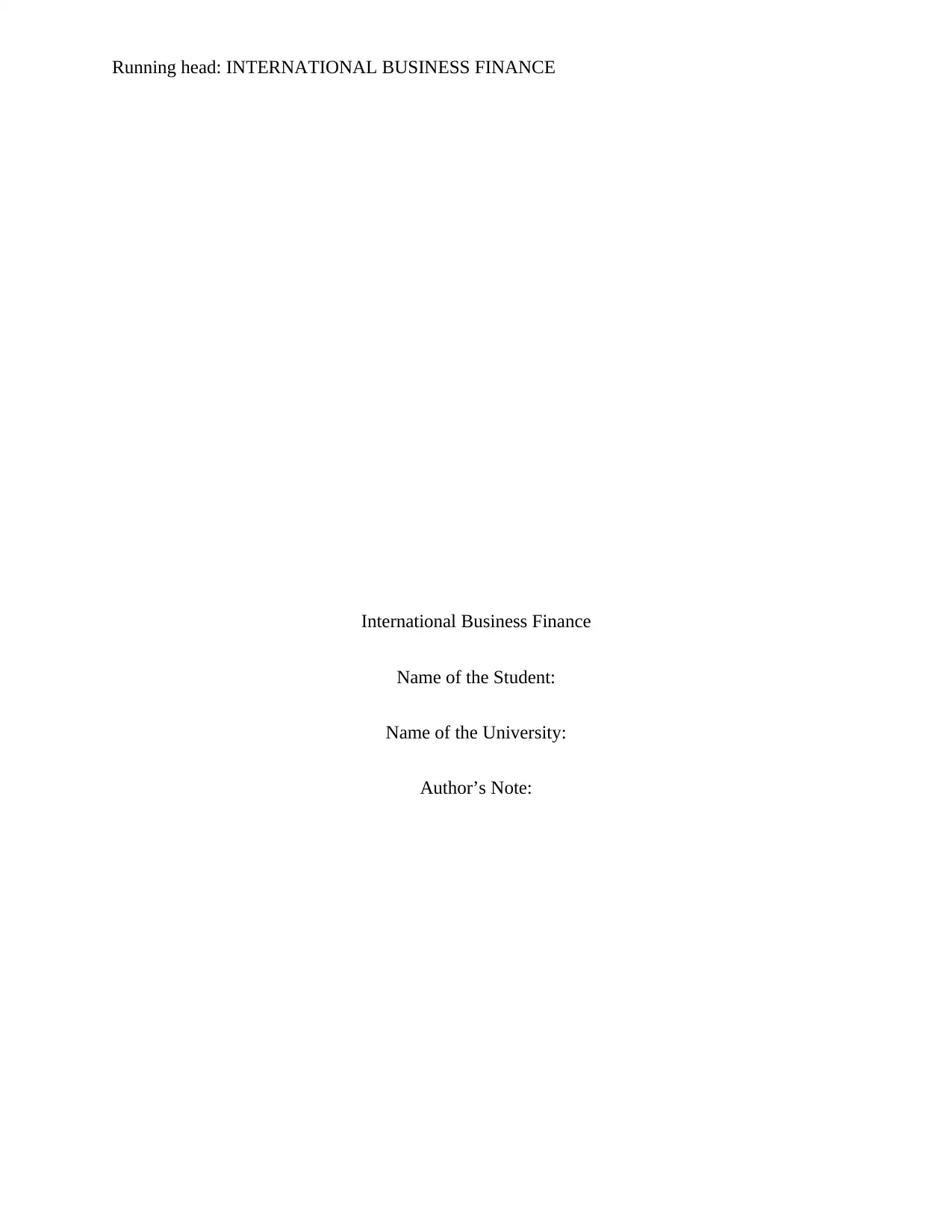
Running head: INTERNATIONAL BUSINESS FINANCE
International Business Finance
Name of the Student:
Name of the University:
Author’s Note:
International Business Finance
Name of the Student:
Name of the University:
Author’s Note:
Paraphrase This Document
Need a fresh take? Get an instant paraphrase of this document with our AI Paraphraser
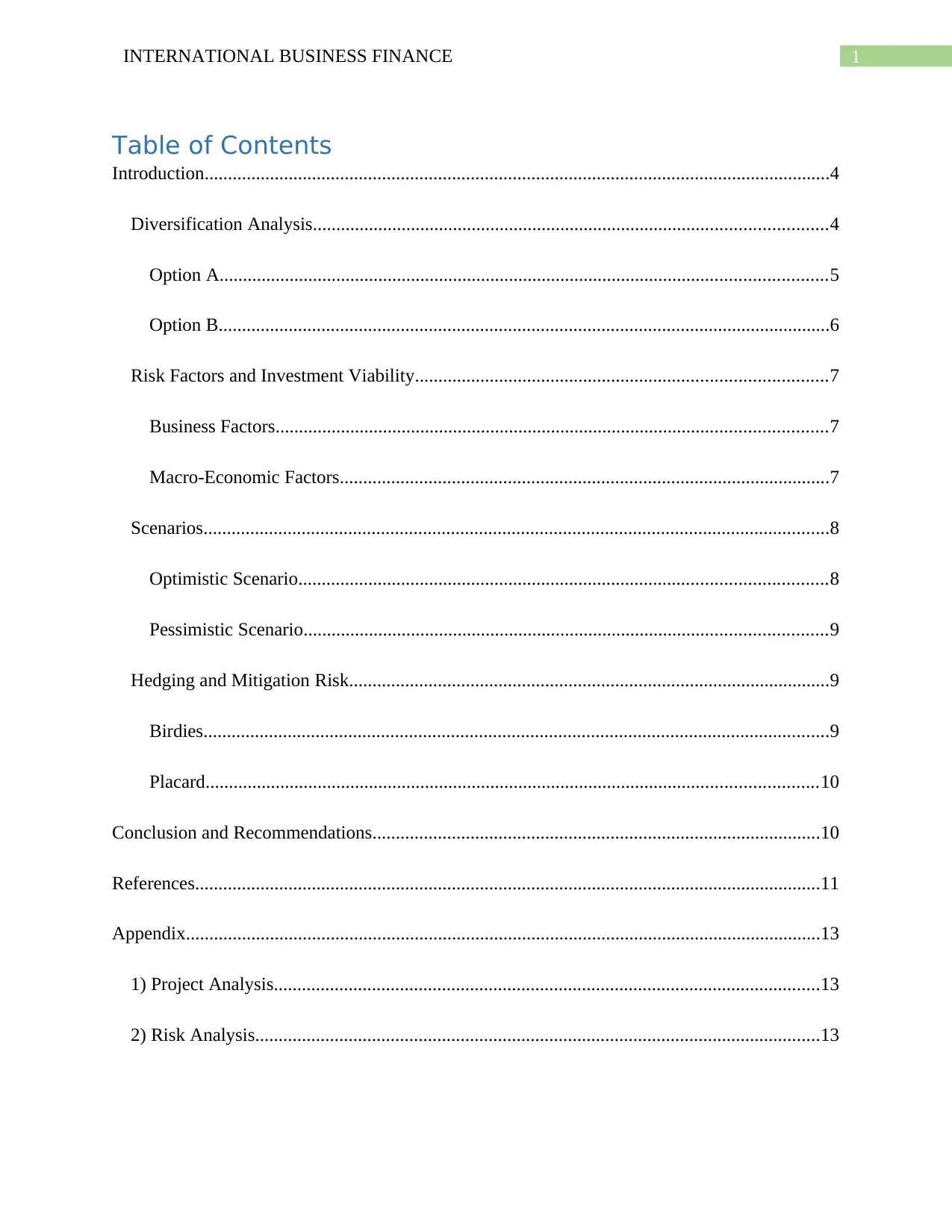
1INTERNATIONAL BUSINESS FINANCE
Table of Contents
Introduction......................................................................................................................................4
Diversification Analysis..............................................................................................................4
Option A..................................................................................................................................5
Option B...................................................................................................................................6
Risk Factors and Investment Viability........................................................................................7
Business Factors......................................................................................................................7
Macro-Economic Factors.........................................................................................................7
Scenarios......................................................................................................................................8
Optimistic Scenario.................................................................................................................8
Pessimistic Scenario................................................................................................................9
Hedging and Mitigation Risk.......................................................................................................9
Birdies......................................................................................................................................9
Placard...................................................................................................................................10
Conclusion and Recommendations................................................................................................10
References......................................................................................................................................11
Appendix........................................................................................................................................13
1) Project Analysis.....................................................................................................................13
2) Risk Analysis.........................................................................................................................13
Table of Contents
Introduction......................................................................................................................................4
Diversification Analysis..............................................................................................................4
Option A..................................................................................................................................5
Option B...................................................................................................................................6
Risk Factors and Investment Viability........................................................................................7
Business Factors......................................................................................................................7
Macro-Economic Factors.........................................................................................................7
Scenarios......................................................................................................................................8
Optimistic Scenario.................................................................................................................8
Pessimistic Scenario................................................................................................................9
Hedging and Mitigation Risk.......................................................................................................9
Birdies......................................................................................................................................9
Placard...................................................................................................................................10
Conclusion and Recommendations................................................................................................10
References......................................................................................................................................11
Appendix........................................................................................................................................13
1) Project Analysis.....................................................................................................................13
2) Risk Analysis.........................................................................................................................13

2INTERNATIONAL BUSINESS FINANCE
⊘ This is a preview!⊘
Do you want full access?
Subscribe today to unlock all pages.

Trusted by 1+ million students worldwide
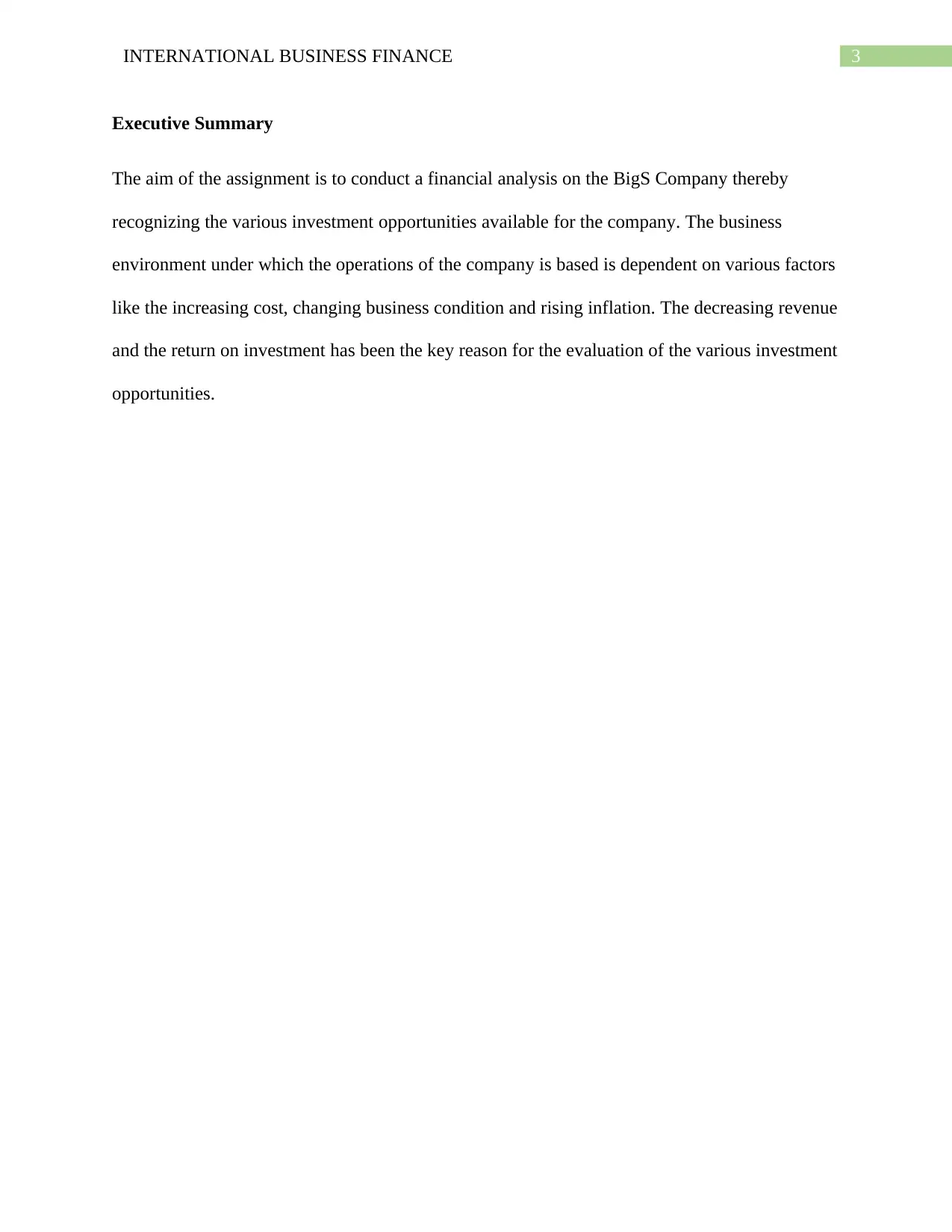
3INTERNATIONAL BUSINESS FINANCE
Executive Summary
The aim of the assignment is to conduct a financial analysis on the BigS Company thereby
recognizing the various investment opportunities available for the company. The business
environment under which the operations of the company is based is dependent on various factors
like the increasing cost, changing business condition and rising inflation. The decreasing revenue
and the return on investment has been the key reason for the evaluation of the various investment
opportunities.
Executive Summary
The aim of the assignment is to conduct a financial analysis on the BigS Company thereby
recognizing the various investment opportunities available for the company. The business
environment under which the operations of the company is based is dependent on various factors
like the increasing cost, changing business condition and rising inflation. The decreasing revenue
and the return on investment has been the key reason for the evaluation of the various investment
opportunities.
Paraphrase This Document
Need a fresh take? Get an instant paraphrase of this document with our AI Paraphraser
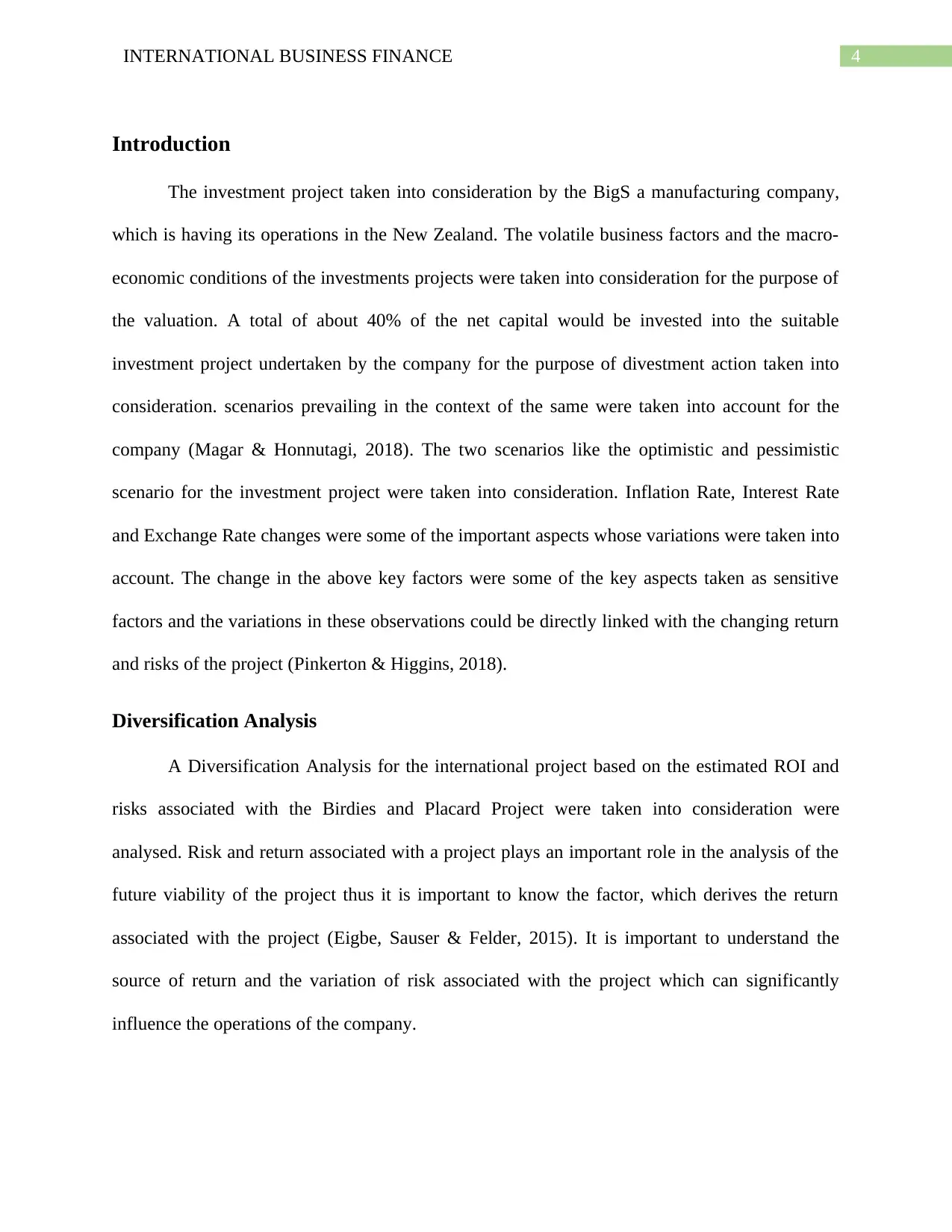
4INTERNATIONAL BUSINESS FINANCE
Introduction
The investment project taken into consideration by the BigS a manufacturing company,
which is having its operations in the New Zealand. The volatile business factors and the macro-
economic conditions of the investments projects were taken into consideration for the purpose of
the valuation. A total of about 40% of the net capital would be invested into the suitable
investment project undertaken by the company for the purpose of divestment action taken into
consideration. scenarios prevailing in the context of the same were taken into account for the
company (Magar & Honnutagi, 2018). The two scenarios like the optimistic and pessimistic
scenario for the investment project were taken into consideration. Inflation Rate, Interest Rate
and Exchange Rate changes were some of the important aspects whose variations were taken into
account. The change in the above key factors were some of the key aspects taken as sensitive
factors and the variations in these observations could be directly linked with the changing return
and risks of the project (Pinkerton & Higgins, 2018).
Diversification Analysis
A Diversification Analysis for the international project based on the estimated ROI and
risks associated with the Birdies and Placard Project were taken into consideration were
analysed. Risk and return associated with a project plays an important role in the analysis of the
future viability of the project thus it is important to know the factor, which derives the return
associated with the project (Eigbe, Sauser & Felder, 2015). It is important to understand the
source of return and the variation of risk associated with the project which can significantly
influence the operations of the company.
Introduction
The investment project taken into consideration by the BigS a manufacturing company,
which is having its operations in the New Zealand. The volatile business factors and the macro-
economic conditions of the investments projects were taken into consideration for the purpose of
the valuation. A total of about 40% of the net capital would be invested into the suitable
investment project undertaken by the company for the purpose of divestment action taken into
consideration. scenarios prevailing in the context of the same were taken into account for the
company (Magar & Honnutagi, 2018). The two scenarios like the optimistic and pessimistic
scenario for the investment project were taken into consideration. Inflation Rate, Interest Rate
and Exchange Rate changes were some of the important aspects whose variations were taken into
account. The change in the above key factors were some of the key aspects taken as sensitive
factors and the variations in these observations could be directly linked with the changing return
and risks of the project (Pinkerton & Higgins, 2018).
Diversification Analysis
A Diversification Analysis for the international project based on the estimated ROI and
risks associated with the Birdies and Placard Project were taken into consideration were
analysed. Risk and return associated with a project plays an important role in the analysis of the
future viability of the project thus it is important to know the factor, which derives the return
associated with the project (Eigbe, Sauser & Felder, 2015). It is important to understand the
source of return and the variation of risk associated with the project which can significantly
influence the operations of the company.
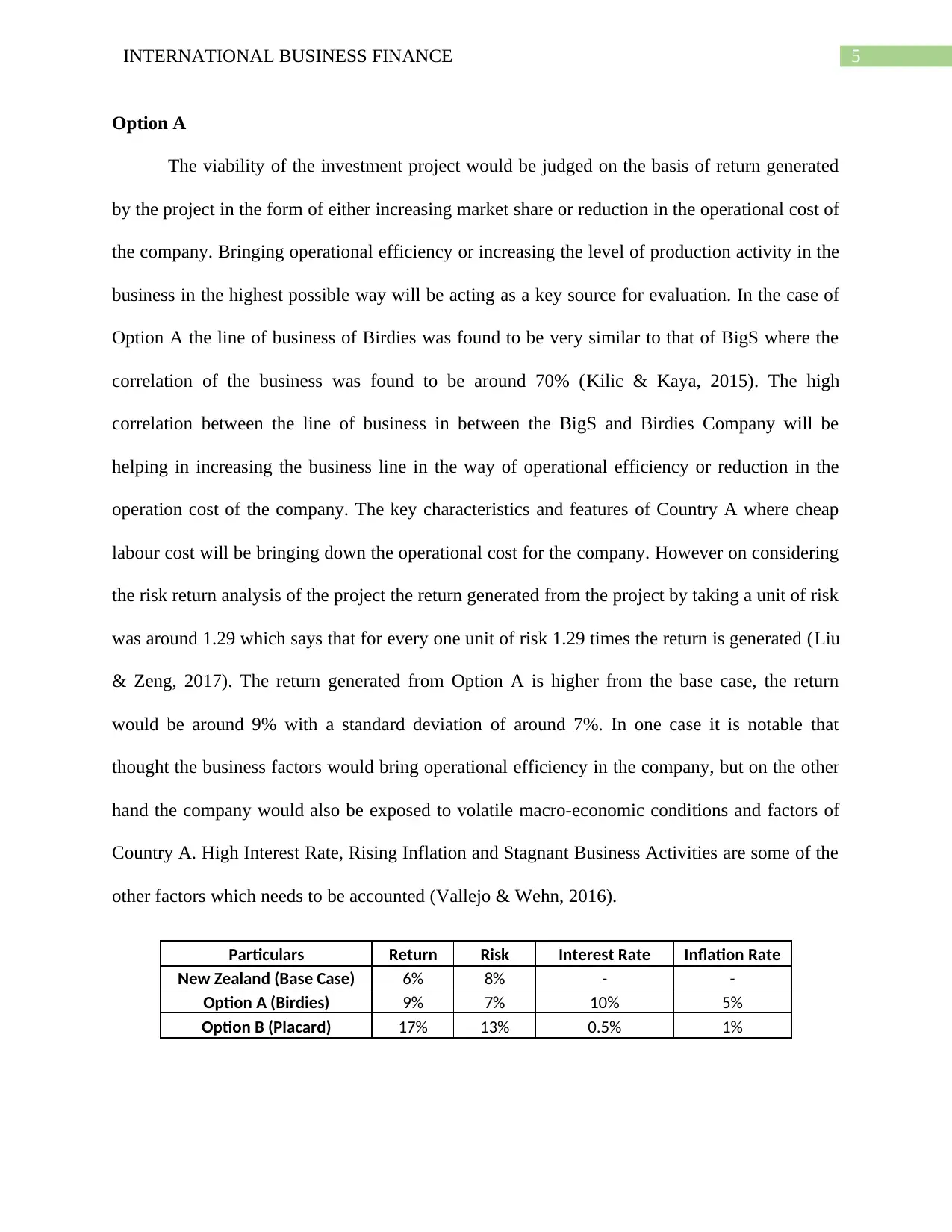
5INTERNATIONAL BUSINESS FINANCE
Option A
The viability of the investment project would be judged on the basis of return generated
by the project in the form of either increasing market share or reduction in the operational cost of
the company. Bringing operational efficiency or increasing the level of production activity in the
business in the highest possible way will be acting as a key source for evaluation. In the case of
Option A the line of business of Birdies was found to be very similar to that of BigS where the
correlation of the business was found to be around 70% (Kilic & Kaya, 2015). The high
correlation between the line of business in between the BigS and Birdies Company will be
helping in increasing the business line in the way of operational efficiency or reduction in the
operation cost of the company. The key characteristics and features of Country A where cheap
labour cost will be bringing down the operational cost for the company. However on considering
the risk return analysis of the project the return generated from the project by taking a unit of risk
was around 1.29 which says that for every one unit of risk 1.29 times the return is generated (Liu
& Zeng, 2017). The return generated from Option A is higher from the base case, the return
would be around 9% with a standard deviation of around 7%. In one case it is notable that
thought the business factors would bring operational efficiency in the company, but on the other
hand the company would also be exposed to volatile macro-economic conditions and factors of
Country A. High Interest Rate, Rising Inflation and Stagnant Business Activities are some of the
other factors which needs to be accounted (Vallejo & Wehn, 2016).
Particulars Return Risk Interest Rate Inflation Rate
New Zealand (Base Case) 6% 8% - -
Option A (Birdies) 9% 7% 10% 5%
Option B (Placard) 17% 13% 0.5% 1%
Option A
The viability of the investment project would be judged on the basis of return generated
by the project in the form of either increasing market share or reduction in the operational cost of
the company. Bringing operational efficiency or increasing the level of production activity in the
business in the highest possible way will be acting as a key source for evaluation. In the case of
Option A the line of business of Birdies was found to be very similar to that of BigS where the
correlation of the business was found to be around 70% (Kilic & Kaya, 2015). The high
correlation between the line of business in between the BigS and Birdies Company will be
helping in increasing the business line in the way of operational efficiency or reduction in the
operation cost of the company. The key characteristics and features of Country A where cheap
labour cost will be bringing down the operational cost for the company. However on considering
the risk return analysis of the project the return generated from the project by taking a unit of risk
was around 1.29 which says that for every one unit of risk 1.29 times the return is generated (Liu
& Zeng, 2017). The return generated from Option A is higher from the base case, the return
would be around 9% with a standard deviation of around 7%. In one case it is notable that
thought the business factors would bring operational efficiency in the company, but on the other
hand the company would also be exposed to volatile macro-economic conditions and factors of
Country A. High Interest Rate, Rising Inflation and Stagnant Business Activities are some of the
other factors which needs to be accounted (Vallejo & Wehn, 2016).
Particulars Return Risk Interest Rate Inflation Rate
New Zealand (Base Case) 6% 8% - -
Option A (Birdies) 9% 7% 10% 5%
Option B (Placard) 17% 13% 0.5% 1%
⊘ This is a preview!⊘
Do you want full access?
Subscribe today to unlock all pages.

Trusted by 1+ million students worldwide
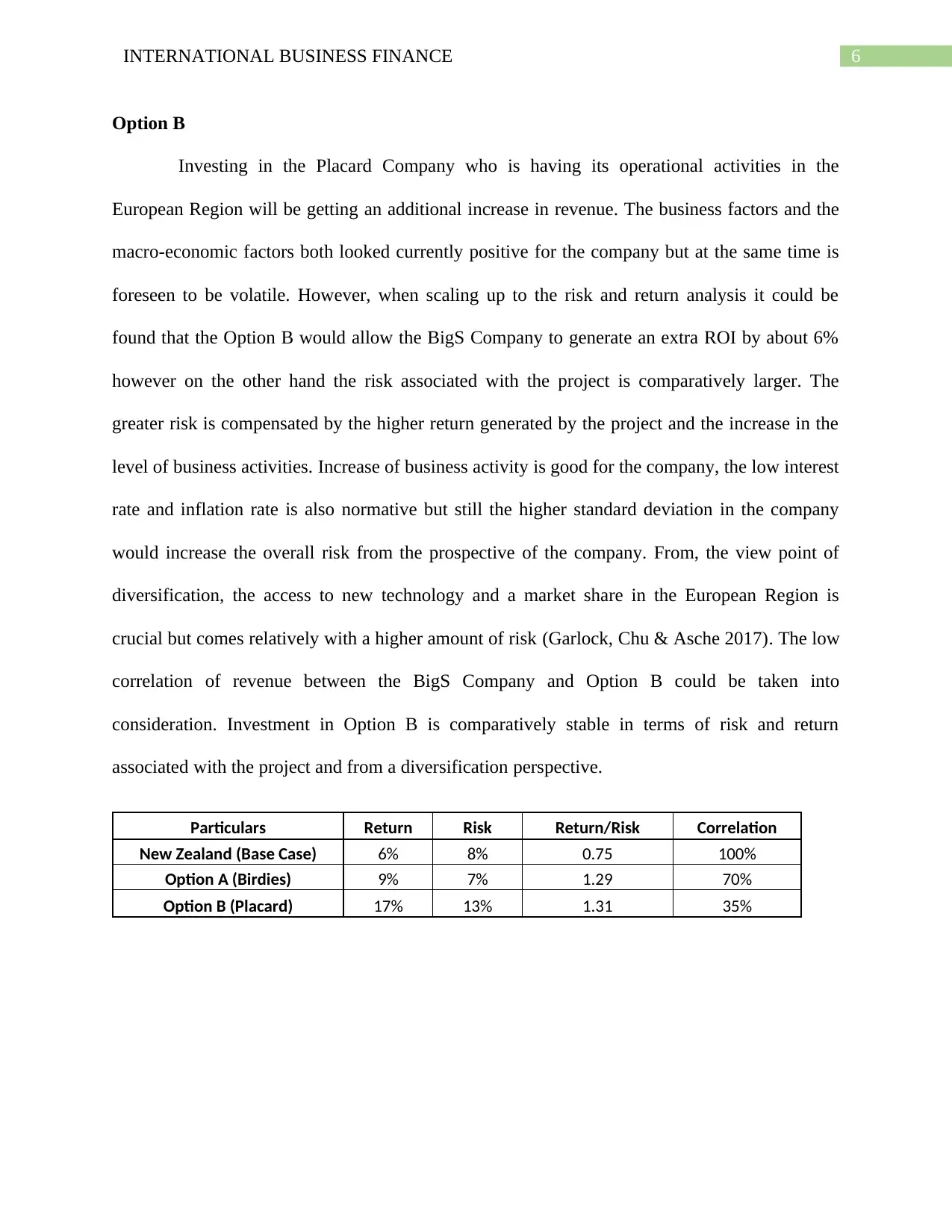
6INTERNATIONAL BUSINESS FINANCE
Option B
Investing in the Placard Company who is having its operational activities in the
European Region will be getting an additional increase in revenue. The business factors and the
macro-economic factors both looked currently positive for the company but at the same time is
foreseen to be volatile. However, when scaling up to the risk and return analysis it could be
found that the Option B would allow the BigS Company to generate an extra ROI by about 6%
however on the other hand the risk associated with the project is comparatively larger. The
greater risk is compensated by the higher return generated by the project and the increase in the
level of business activities. Increase of business activity is good for the company, the low interest
rate and inflation rate is also normative but still the higher standard deviation in the company
would increase the overall risk from the prospective of the company. From, the view point of
diversification, the access to new technology and a market share in the European Region is
crucial but comes relatively with a higher amount of risk (Garlock, Chu & Asche 2017). The low
correlation of revenue between the BigS Company and Option B could be taken into
consideration. Investment in Option B is comparatively stable in terms of risk and return
associated with the project and from a diversification perspective.
Particulars Return Risk Return/Risk Correlation
New Zealand (Base Case) 6% 8% 0.75 100%
Option A (Birdies) 9% 7% 1.29 70%
Option B (Placard) 17% 13% 1.31 35%
Option B
Investing in the Placard Company who is having its operational activities in the
European Region will be getting an additional increase in revenue. The business factors and the
macro-economic factors both looked currently positive for the company but at the same time is
foreseen to be volatile. However, when scaling up to the risk and return analysis it could be
found that the Option B would allow the BigS Company to generate an extra ROI by about 6%
however on the other hand the risk associated with the project is comparatively larger. The
greater risk is compensated by the higher return generated by the project and the increase in the
level of business activities. Increase of business activity is good for the company, the low interest
rate and inflation rate is also normative but still the higher standard deviation in the company
would increase the overall risk from the prospective of the company. From, the view point of
diversification, the access to new technology and a market share in the European Region is
crucial but comes relatively with a higher amount of risk (Garlock, Chu & Asche 2017). The low
correlation of revenue between the BigS Company and Option B could be taken into
consideration. Investment in Option B is comparatively stable in terms of risk and return
associated with the project and from a diversification perspective.
Particulars Return Risk Return/Risk Correlation
New Zealand (Base Case) 6% 8% 0.75 100%
Option A (Birdies) 9% 7% 1.29 70%
Option B (Placard) 17% 13% 1.31 35%
Paraphrase This Document
Need a fresh take? Get an instant paraphrase of this document with our AI Paraphraser
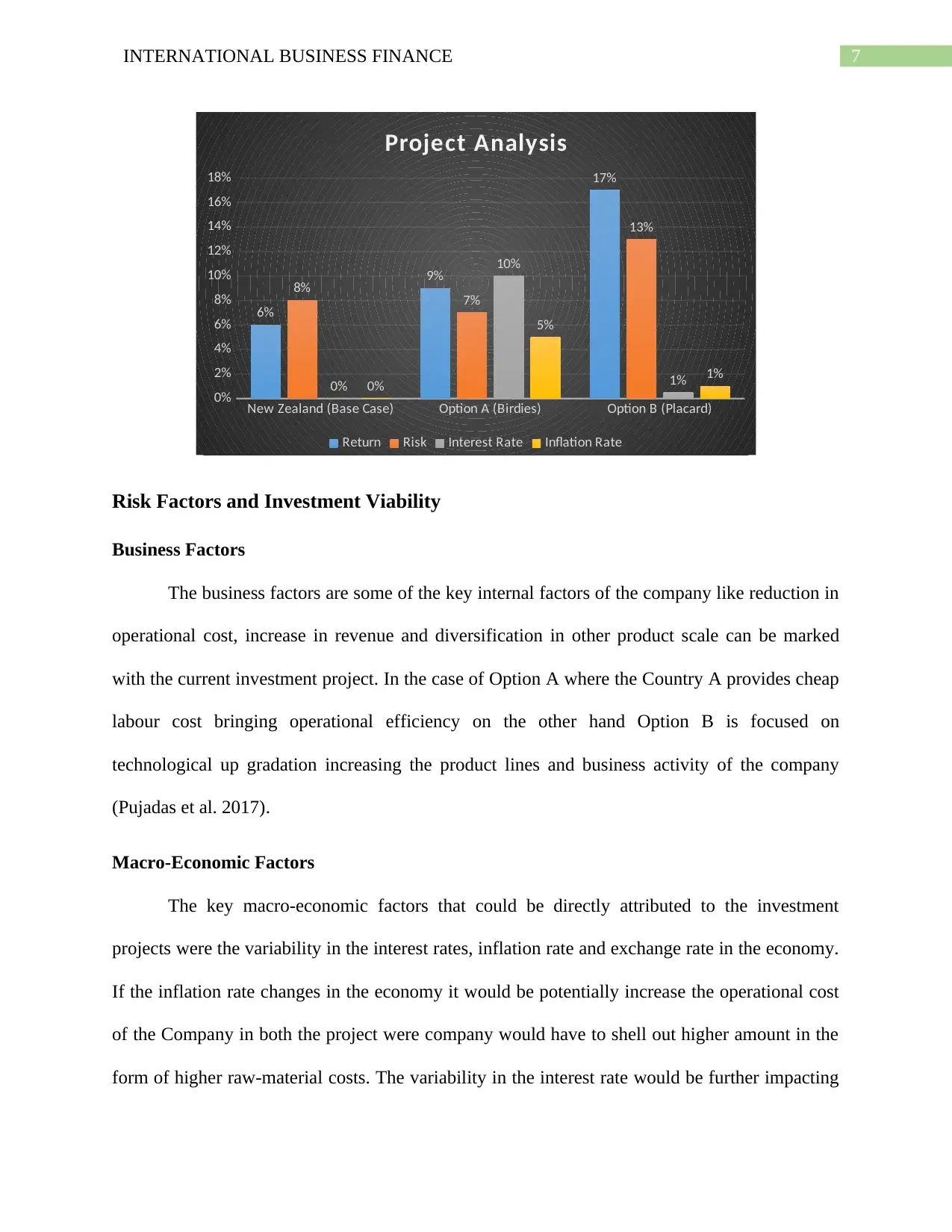
7INTERNATIONAL BUSINESS FINANCE
New Zealand (Base Case) Option A (Birdies) Option B (Placard)
0%
2%
4%
6%
8%
10%
12%
14%
16%
18%
6%
9%
17%
8% 7%
13%
0%
10%
1%0%
5%
1%
Project Analysis
Return Risk Interest Rate Inflation Rate
Risk Factors and Investment Viability
Business Factors
The business factors are some of the key internal factors of the company like reduction in
operational cost, increase in revenue and diversification in other product scale can be marked
with the current investment project. In the case of Option A where the Country A provides cheap
labour cost bringing operational efficiency on the other hand Option B is focused on
technological up gradation increasing the product lines and business activity of the company
(Pujadas et al. 2017).
Macro-Economic Factors
The key macro-economic factors that could be directly attributed to the investment
projects were the variability in the interest rates, inflation rate and exchange rate in the economy.
If the inflation rate changes in the economy it would be potentially increase the operational cost
of the Company in both the project were company would have to shell out higher amount in the
form of higher raw-material costs. The variability in the interest rate would be further impacting
New Zealand (Base Case) Option A (Birdies) Option B (Placard)
0%
2%
4%
6%
8%
10%
12%
14%
16%
18%
6%
9%
17%
8% 7%
13%
0%
10%
1%0%
5%
1%
Project Analysis
Return Risk Interest Rate Inflation Rate
Risk Factors and Investment Viability
Business Factors
The business factors are some of the key internal factors of the company like reduction in
operational cost, increase in revenue and diversification in other product scale can be marked
with the current investment project. In the case of Option A where the Country A provides cheap
labour cost bringing operational efficiency on the other hand Option B is focused on
technological up gradation increasing the product lines and business activity of the company
(Pujadas et al. 2017).
Macro-Economic Factors
The key macro-economic factors that could be directly attributed to the investment
projects were the variability in the interest rates, inflation rate and exchange rate in the economy.
If the inflation rate changes in the economy it would be potentially increase the operational cost
of the Company in both the project were company would have to shell out higher amount in the
form of higher raw-material costs. The variability in the interest rate would be further impacting
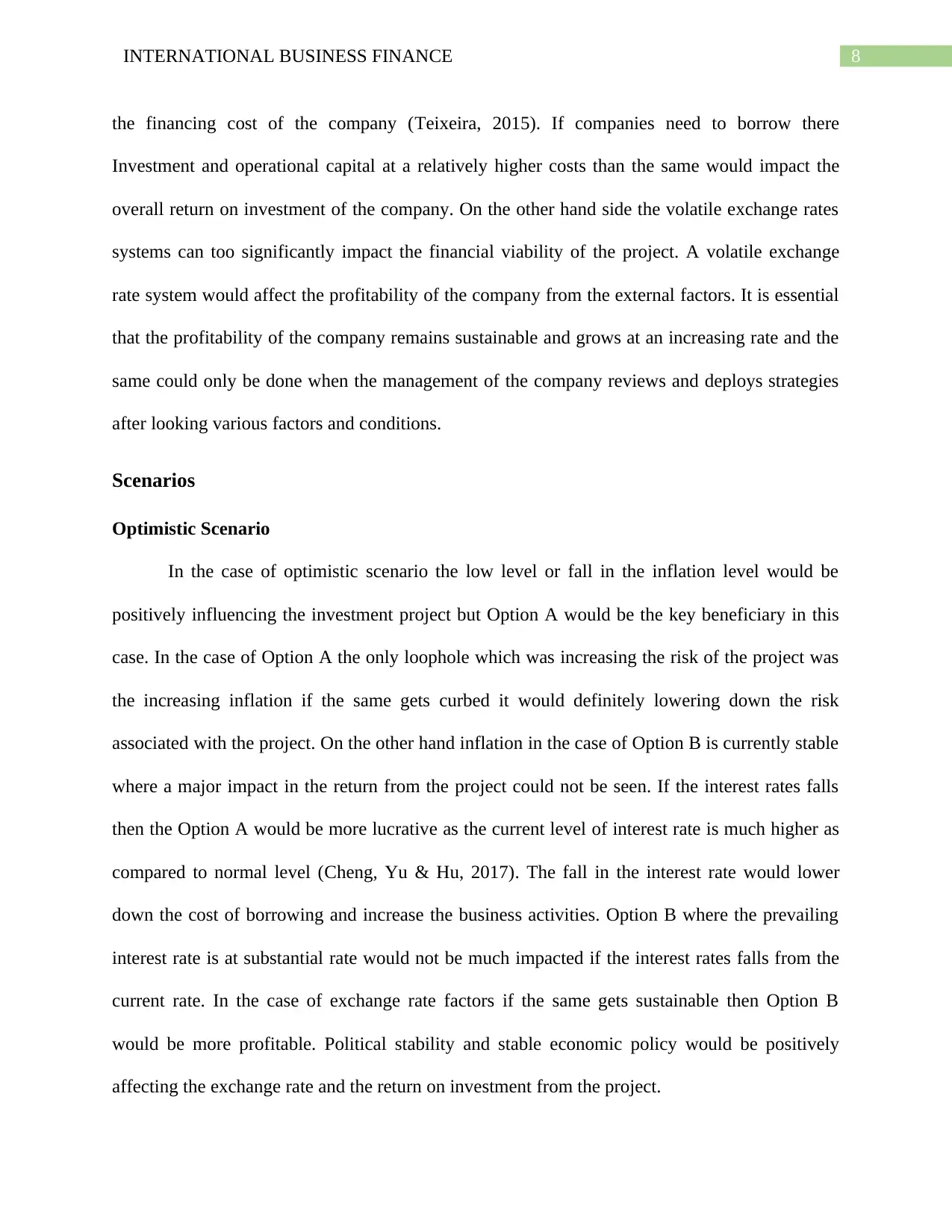
8INTERNATIONAL BUSINESS FINANCE
the financing cost of the company (Teixeira, 2015). If companies need to borrow there
Investment and operational capital at a relatively higher costs than the same would impact the
overall return on investment of the company. On the other hand side the volatile exchange rates
systems can too significantly impact the financial viability of the project. A volatile exchange
rate system would affect the profitability of the company from the external factors. It is essential
that the profitability of the company remains sustainable and grows at an increasing rate and the
same could only be done when the management of the company reviews and deploys strategies
after looking various factors and conditions.
Scenarios
Optimistic Scenario
In the case of optimistic scenario the low level or fall in the inflation level would be
positively influencing the investment project but Option A would be the key beneficiary in this
case. In the case of Option A the only loophole which was increasing the risk of the project was
the increasing inflation if the same gets curbed it would definitely lowering down the risk
associated with the project. On the other hand inflation in the case of Option B is currently stable
where a major impact in the return from the project could not be seen. If the interest rates falls
then the Option A would be more lucrative as the current level of interest rate is much higher as
compared to normal level (Cheng, Yu & Hu, 2017). The fall in the interest rate would lower
down the cost of borrowing and increase the business activities. Option B where the prevailing
interest rate is at substantial rate would not be much impacted if the interest rates falls from the
current rate. In the case of exchange rate factors if the same gets sustainable then Option B
would be more profitable. Political stability and stable economic policy would be positively
affecting the exchange rate and the return on investment from the project.
the financing cost of the company (Teixeira, 2015). If companies need to borrow there
Investment and operational capital at a relatively higher costs than the same would impact the
overall return on investment of the company. On the other hand side the volatile exchange rates
systems can too significantly impact the financial viability of the project. A volatile exchange
rate system would affect the profitability of the company from the external factors. It is essential
that the profitability of the company remains sustainable and grows at an increasing rate and the
same could only be done when the management of the company reviews and deploys strategies
after looking various factors and conditions.
Scenarios
Optimistic Scenario
In the case of optimistic scenario the low level or fall in the inflation level would be
positively influencing the investment project but Option A would be the key beneficiary in this
case. In the case of Option A the only loophole which was increasing the risk of the project was
the increasing inflation if the same gets curbed it would definitely lowering down the risk
associated with the project. On the other hand inflation in the case of Option B is currently stable
where a major impact in the return from the project could not be seen. If the interest rates falls
then the Option A would be more lucrative as the current level of interest rate is much higher as
compared to normal level (Cheng, Yu & Hu, 2017). The fall in the interest rate would lower
down the cost of borrowing and increase the business activities. Option B where the prevailing
interest rate is at substantial rate would not be much impacted if the interest rates falls from the
current rate. In the case of exchange rate factors if the same gets sustainable then Option B
would be more profitable. Political stability and stable economic policy would be positively
affecting the exchange rate and the return on investment from the project.
⊘ This is a preview!⊘
Do you want full access?
Subscribe today to unlock all pages.

Trusted by 1+ million students worldwide
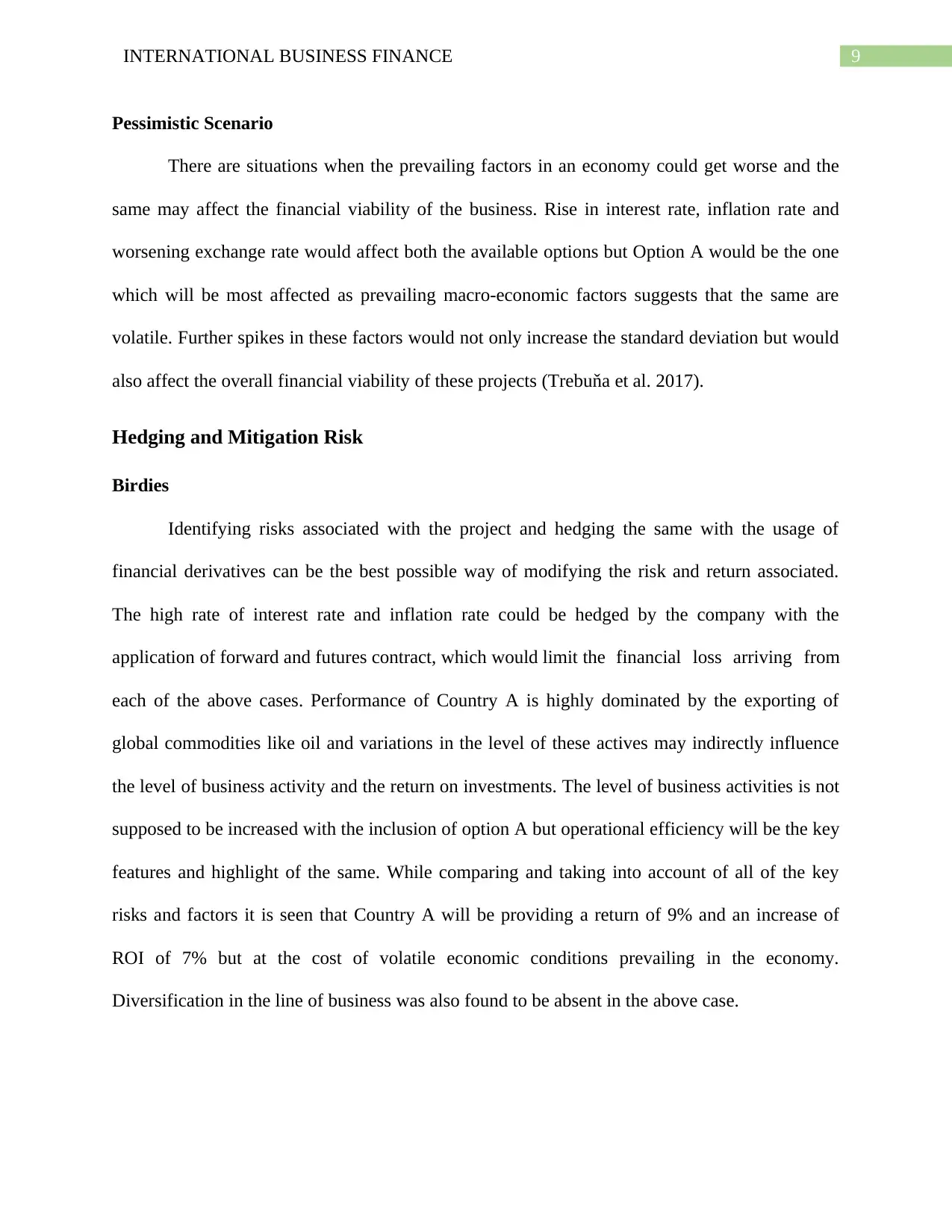
9INTERNATIONAL BUSINESS FINANCE
Pessimistic Scenario
There are situations when the prevailing factors in an economy could get worse and the
same may affect the financial viability of the business. Rise in interest rate, inflation rate and
worsening exchange rate would affect both the available options but Option A would be the one
which will be most affected as prevailing macro-economic factors suggests that the same are
volatile. Further spikes in these factors would not only increase the standard deviation but would
also affect the overall financial viability of these projects (Trebuňa et al. 2017).
Hedging and Mitigation Risk
Birdies
Identifying risks associated with the project and hedging the same with the usage of
financial derivatives can be the best possible way of modifying the risk and return associated.
The high rate of interest rate and inflation rate could be hedged by the company with the
application of forward and futures contract, which would limit the financial loss arriving from
each of the above cases. Performance of Country A is highly dominated by the exporting of
global commodities like oil and variations in the level of these actives may indirectly influence
the level of business activity and the return on investments. The level of business activities is not
supposed to be increased with the inclusion of option A but operational efficiency will be the key
features and highlight of the same. While comparing and taking into account of all of the key
risks and factors it is seen that Country A will be providing a return of 9% and an increase of
ROI of 7% but at the cost of volatile economic conditions prevailing in the economy.
Diversification in the line of business was also found to be absent in the above case.
Pessimistic Scenario
There are situations when the prevailing factors in an economy could get worse and the
same may affect the financial viability of the business. Rise in interest rate, inflation rate and
worsening exchange rate would affect both the available options but Option A would be the one
which will be most affected as prevailing macro-economic factors suggests that the same are
volatile. Further spikes in these factors would not only increase the standard deviation but would
also affect the overall financial viability of these projects (Trebuňa et al. 2017).
Hedging and Mitigation Risk
Birdies
Identifying risks associated with the project and hedging the same with the usage of
financial derivatives can be the best possible way of modifying the risk and return associated.
The high rate of interest rate and inflation rate could be hedged by the company with the
application of forward and futures contract, which would limit the financial loss arriving from
each of the above cases. Performance of Country A is highly dominated by the exporting of
global commodities like oil and variations in the level of these actives may indirectly influence
the level of business activity and the return on investments. The level of business activities is not
supposed to be increased with the inclusion of option A but operational efficiency will be the key
features and highlight of the same. While comparing and taking into account of all of the key
risks and factors it is seen that Country A will be providing a return of 9% and an increase of
ROI of 7% but at the cost of volatile economic conditions prevailing in the economy.
Diversification in the line of business was also found to be absent in the above case.
Paraphrase This Document
Need a fresh take? Get an instant paraphrase of this document with our AI Paraphraser
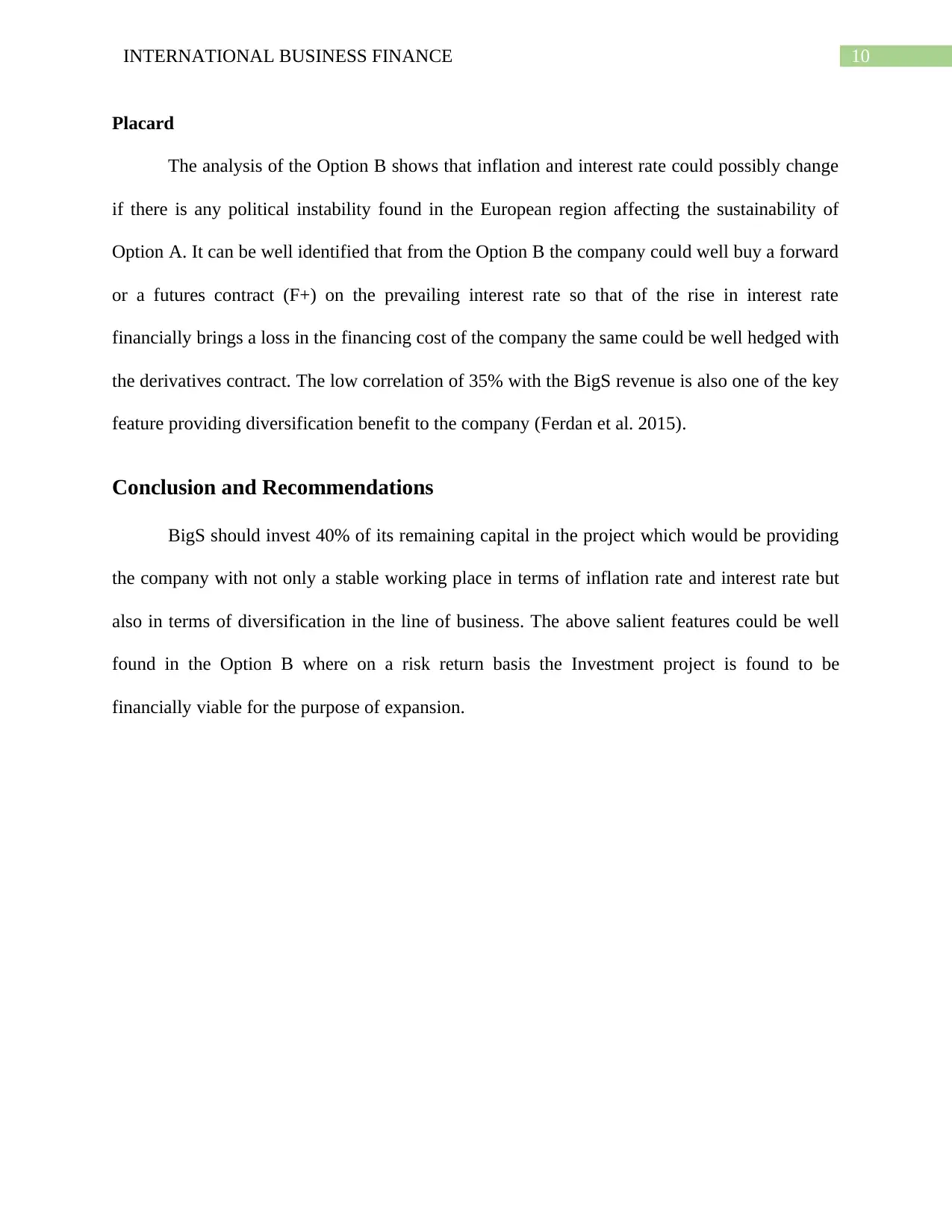
10INTERNATIONAL BUSINESS FINANCE
Placard
The analysis of the Option B shows that inflation and interest rate could possibly change
if there is any political instability found in the European region affecting the sustainability of
Option A. It can be well identified that from the Option B the company could well buy a forward
or a futures contract (F+) on the prevailing interest rate so that of the rise in interest rate
financially brings a loss in the financing cost of the company the same could be well hedged with
the derivatives contract. The low correlation of 35% with the BigS revenue is also one of the key
feature providing diversification benefit to the company (Ferdan et al. 2015).
Conclusion and Recommendations
BigS should invest 40% of its remaining capital in the project which would be providing
the company with not only a stable working place in terms of inflation rate and interest rate but
also in terms of diversification in the line of business. The above salient features could be well
found in the Option B where on a risk return basis the Investment project is found to be
financially viable for the purpose of expansion.
Placard
The analysis of the Option B shows that inflation and interest rate could possibly change
if there is any political instability found in the European region affecting the sustainability of
Option A. It can be well identified that from the Option B the company could well buy a forward
or a futures contract (F+) on the prevailing interest rate so that of the rise in interest rate
financially brings a loss in the financing cost of the company the same could be well hedged with
the derivatives contract. The low correlation of 35% with the BigS revenue is also one of the key
feature providing diversification benefit to the company (Ferdan et al. 2015).
Conclusion and Recommendations
BigS should invest 40% of its remaining capital in the project which would be providing
the company with not only a stable working place in terms of inflation rate and interest rate but
also in terms of diversification in the line of business. The above salient features could be well
found in the Option B where on a risk return basis the Investment project is found to be
financially viable for the purpose of expansion.
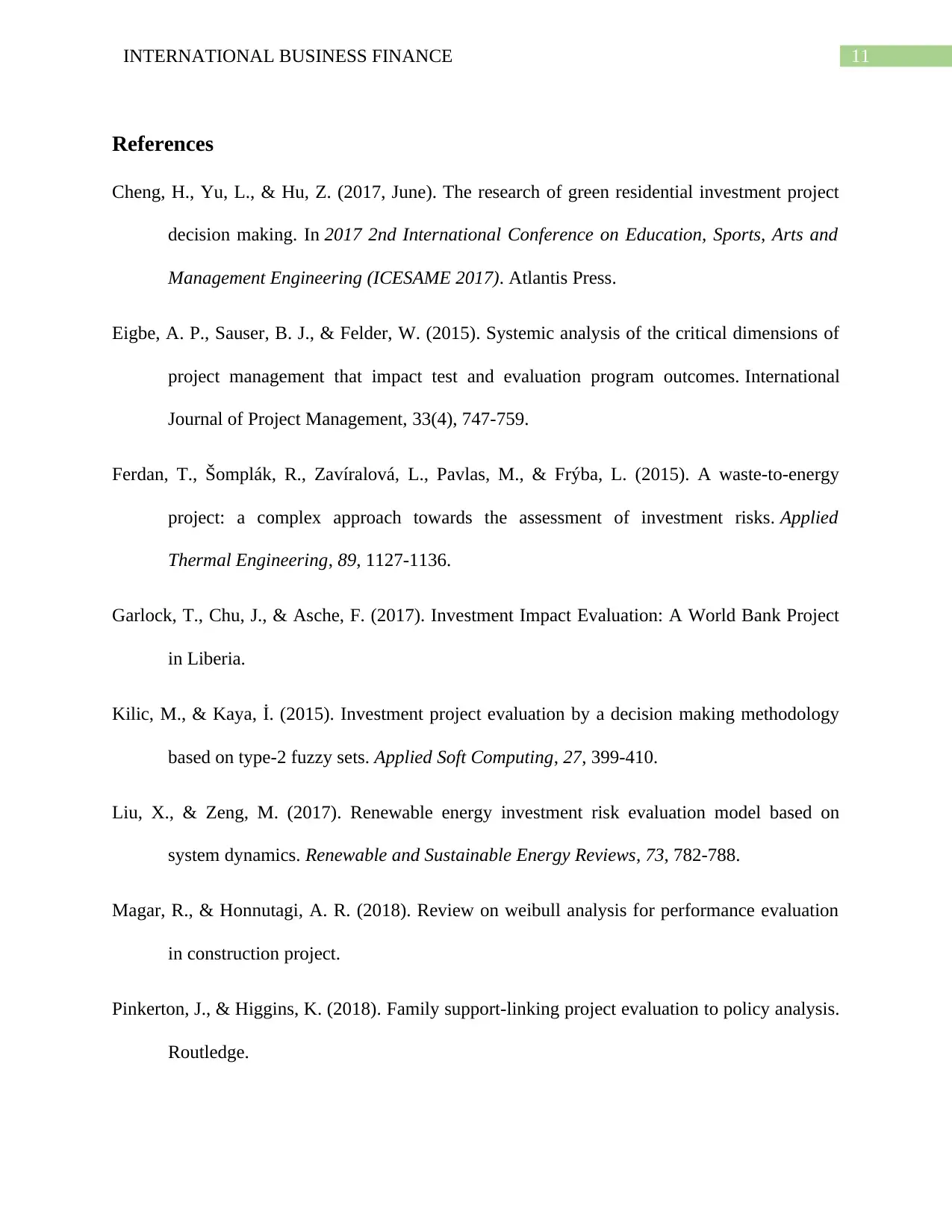
11INTERNATIONAL BUSINESS FINANCE
References
Cheng, H., Yu, L., & Hu, Z. (2017, June). The research of green residential investment project
decision making. In 2017 2nd International Conference on Education, Sports, Arts and
Management Engineering (ICESAME 2017). Atlantis Press.
Eigbe, A. P., Sauser, B. J., & Felder, W. (2015). Systemic analysis of the critical dimensions of
project management that impact test and evaluation program outcomes. International
Journal of Project Management, 33(4), 747-759.
Ferdan, T., Šomplák, R., Zavíralová, L., Pavlas, M., & Frýba, L. (2015). A waste-to-energy
project: a complex approach towards the assessment of investment risks. Applied
Thermal Engineering, 89, 1127-1136.
Garlock, T., Chu, J., & Asche, F. (2017). Investment Impact Evaluation: A World Bank Project
in Liberia.
Kilic, M., & Kaya, İ. (2015). Investment project evaluation by a decision making methodology
based on type-2 fuzzy sets. Applied Soft Computing, 27, 399-410.
Liu, X., & Zeng, M. (2017). Renewable energy investment risk evaluation model based on
system dynamics. Renewable and Sustainable Energy Reviews, 73, 782-788.
Magar, R., & Honnutagi, A. R. (2018). Review on weibull analysis for performance evaluation
in construction project.
Pinkerton, J., & Higgins, K. (2018). Family support-linking project evaluation to policy analysis.
Routledge.
References
Cheng, H., Yu, L., & Hu, Z. (2017, June). The research of green residential investment project
decision making. In 2017 2nd International Conference on Education, Sports, Arts and
Management Engineering (ICESAME 2017). Atlantis Press.
Eigbe, A. P., Sauser, B. J., & Felder, W. (2015). Systemic analysis of the critical dimensions of
project management that impact test and evaluation program outcomes. International
Journal of Project Management, 33(4), 747-759.
Ferdan, T., Šomplák, R., Zavíralová, L., Pavlas, M., & Frýba, L. (2015). A waste-to-energy
project: a complex approach towards the assessment of investment risks. Applied
Thermal Engineering, 89, 1127-1136.
Garlock, T., Chu, J., & Asche, F. (2017). Investment Impact Evaluation: A World Bank Project
in Liberia.
Kilic, M., & Kaya, İ. (2015). Investment project evaluation by a decision making methodology
based on type-2 fuzzy sets. Applied Soft Computing, 27, 399-410.
Liu, X., & Zeng, M. (2017). Renewable energy investment risk evaluation model based on
system dynamics. Renewable and Sustainable Energy Reviews, 73, 782-788.
Magar, R., & Honnutagi, A. R. (2018). Review on weibull analysis for performance evaluation
in construction project.
Pinkerton, J., & Higgins, K. (2018). Family support-linking project evaluation to policy analysis.
Routledge.
⊘ This is a preview!⊘
Do you want full access?
Subscribe today to unlock all pages.

Trusted by 1+ million students worldwide
1 out of 14
Related Documents
Your All-in-One AI-Powered Toolkit for Academic Success.
+13062052269
info@desklib.com
Available 24*7 on WhatsApp / Email
![[object Object]](/_next/static/media/star-bottom.7253800d.svg)
Unlock your academic potential
Copyright © 2020–2025 A2Z Services. All Rights Reserved. Developed and managed by ZUCOL.





